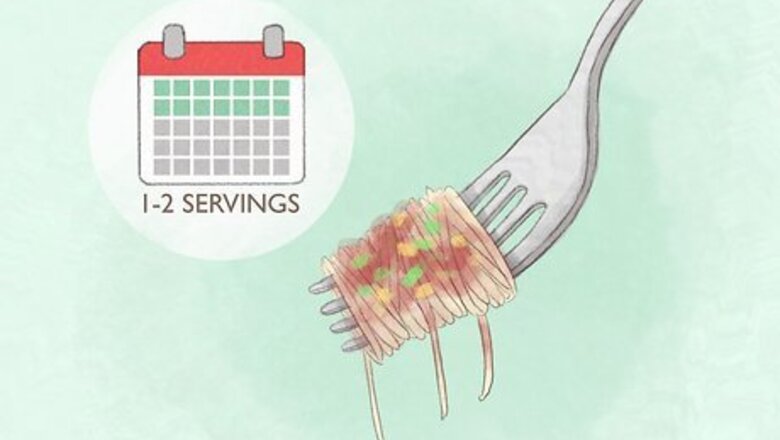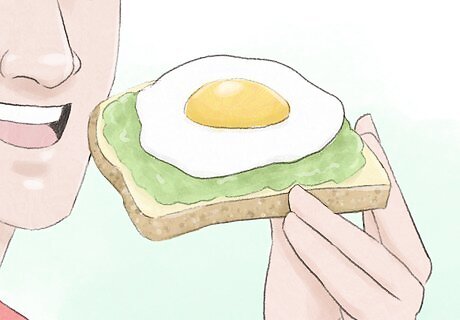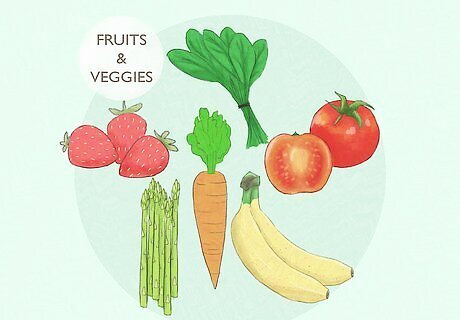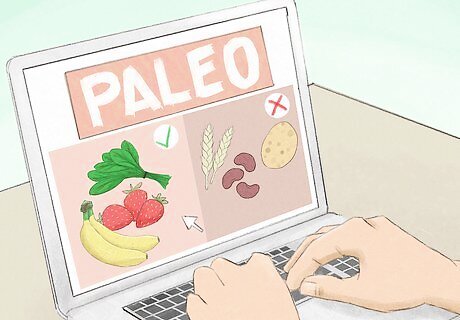
views
Adding Carbs and Balancing Your Diet

Eat 1 to 2 servings of carbs for the first 2 weeks. As a general rule of thumb, try to limit your intake of new carbs to 1 or 2 servings, or about 10 g of carbs per week for the first 2 weeks. Introducing carbs gradually will give your body time to adjust and help you avoid gastrointestinal issues. The amount of carbs each person can reintroduce each day or week varies, so if you’re limiting your intake but still experiencing discomfort, contact your doctor or talk to a dietician to figure out a plan that works for you. You can also try increasing your intake of carbs by 10% each day for the first 2 weeks.

Increase your intake of carbs to the recommended amount after 2 weeks. After reintroducing carbs into your diet gradually for the first 2 weeks, start eating the daily amount recommended by your doctor or generally recommended for your age, height, weight, and level of activity. Adding healthy carbs back into your regular diet can give you more energy, protect against some cardiovascular diseases, improve your digestive health, and help you control your weight. While recommendations vary from one person to the next, it’s generally recommended that carbs make up 45 to 65 percent of your total calories per day. If you eat about 2,000 calories per day, for example, about 900 to 1,300 of those calories should come from carbs.

Make lean proteins a staple of your diet. As you transition off keto, try introducing more lean proteins to your diet to keep your energy up and help your body adjust easier. As you add more carbs to your diet, you’ll naturally need to decrease the amount of other foods you consume to avoid overeating. It’s important, however, to start or continue making lean proteins a staple of your diet to help you stay full and avoid gaining weight. The amount of protein you should consume daily varies greatly depending on your age, weight, and activity level. For example, it’s generally recommended that a 50-year-old woman who weighs 140 pounds (64 kg) and does little exercise should eat about 53 grams (1.9 oz) of protein per day. Salmon, turn, turkey, chicken, Greek yogurt, nuts, and eggs are all healthy sources of protein.

Continue eating healthy fats to combat hunger. When you start introducing carbs back into your diet, you may find that you feel hungry more often, even after meals. This can lead to overeating and weight gain. To keep unnecessary hunger at bay, make sure that you continue to include the healthy fats you consumed during keto in your diet after keto. While it varies from one person to the next, it’s generally recommended that monounsaturated fats make up 15 to 20% of your diet, polyunsaturated fats make up 5 to 10% of your diet, and saturated fats make up less than 10% each day. Olive oil, nuts, and avocados are all great source of healthy monounsaturated fats. Sunflower oil, flaxseeds, chia seeds, and cold-water fish are all great sources of polyunsaturated fats.
Eating the Right Carbs

Reintroduce fruits and vegetables first to make the transition easier. When adding carbs back into your diet, it’s important that you give your body time to adjust by starting with carbs that are unprocessed and all natural. Many fruits and vegetables are high in antioxidants and fiber that will help you stay full as you decrease your intake of fats. Strawberries, carrots, and squash are great fiber-rich options to start with.

Choose carbs that are high in protein and fiber. As you gradually reintroduce carbs into your diet, focus on options that are high in protein and fiber to help you stave off hunger and stomach issues. Beans, crackers with seeds, and sprouted breads are all great options that’ll make your transition off keto easier and healthier. These carbs take longer to digest than sugary carbs, which will keep you full longer and give your body time to adjust as you reintroduce these nutrients.

Avoid carbs that are high in sugar. While you may be looking forward to an occasional indulgence after keto, it’s best to avoid consuming any sugar-heavy carbs until your body has had at least 2 weeks to adjust. Carbs like cookies and donuts can cause your blood sugar to spike, which can make you feel tired and irritable while increasing your sugar cravings. As a rule of thumb, avoid anything that has more than 4 grams of added sugar during your transition off keto. Processed foods that are high in sugar often contain empty calories that won’t keep you full for long. Therefore, try to avoid these and continue to eat some of your favorite keto options for snacks and meals.

Add more carbs with probiotics to combat bloating. When you reintroduce carbs into your diet, it’s likely that you’ll experience some gastrointestinal issues, such as bloating. Adding more probiotics into your diet can help keep these symptoms at bay so you can start eating carbs gradually without any discomfort. Yogurt and fermented foods, such as miso and sauerkraut, are great options for healthy carbs that contain probiotics that may ease your transition off keto.
Transitioning off Keto Healthily

Give your body about 14 days to adjust to your dietary changes. When you transition off keto and start reintroducing carbs into your diet, your body is naturally going to need time to adjust to the change. Even if you reintroduce carbs slowly, you may still experiences weight fluctuations, bloating, blood sugar spikes, and increased feelings of hunger for the first few weeks. While choosing the right carbs can help stave off some of these effects, be patient with your body and understand that some side effects are both normal and expected.

Transition to a paleo or Mediterranean diet to help monitor your intake. If you want to reintroduce carbs but you aren’t sure how to regulate your intake, try transitioning to either the paleo or Mediterranean diet. Both of these diets are similar to keto in requiring healthy fats and protein, but they also include carbs in moderation. Therefore, if you have trouble transitioning off keto without sticking to a strict diet, both of these options can help you. Like the keto diet, the paleo diet requires that you cut out grains, legumes, and dairy, but allows you to eat fruit and vegetable carbs. The Mediterranean diet requires that you cut out sugar and processed carbs, but encourages you to eat whole grains, fruits, and vegetables.

Eat most of your carbs right before or after exercise. To help your body process carbs as you transition off the keto diet, plan to eat most of your carbs either right before or right after you workout. Your body will use the carbs to fuel your work or replenish afterwards, which will speed up your metabolism and make them easier to digest. Maintaining a regular exercise regime will also help you avoid gaining weight as you gradually reintroduce carbs into your diet.

Get plenty of sleep to help your body process carbohydrates. As you transition off the keto diet and reintroduce carbs, your body may be particularly susceptible to gastrointestinal issues, inflammation, blood sugar spikes, and changes in your insulin levels. Sleep makes it easier on your body to process carbs and incorporate them comfortably back into your diet. In addition, getting plenty of sleep will help you manage your stress, which can also impact your body’s ability to handle new foods and process carbs.

Meet with a dietitian to help you assess your nutritional needs. If you’re struggling to figure out how to transition off keto and reintroduce carbs in a healthy manner, meeting with a dietician may be a good option for you. While you can safely and effectively reintroduce carbs on your own, seeing a dietitian before going off keto can help you come up with a plan tailored to your specific nutritional needs. The amount of carbs that each person needs and can comfortably eat while transitioning off keto can vary greatly. Therefore, if you’re struggling to find what works for your body, talk to a dietician to see what you may need to change.



















Comments
0 comment